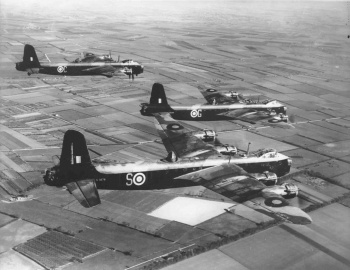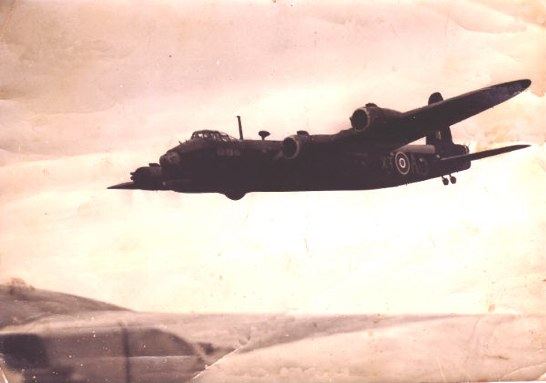Short Stirling specifications and other notes
The Stirling was the tallest of any aircraft to serve with the RAF in World War Two being 22 feet and 9 inches from the ground at her highest point. Tip of the nose to the end of her guns at the tail was a shade over 87 feet, which also made her the longest of any RAF aircraft in the War.
The Stirling was the result of Air Ministry specification B12/36, which called for a heavy bomber, capable of being launched via a catapult system?, able to maintain height with one of its four engines shut down and carry a heavy bomb load. The spec also called for a wing span of no more than 100 feet. The Shorts company (of Sunderland flying boat fame) produced plans for a heavy bomber that drew on some of the successful design points of the Sunderland. A wingspan of 112 feet was part of the design, but the Air Ministry was opposed to it and insisted on the maximum wingspan of 100 feet in order that the Stirling would fit in the then standard RAF hangar. This shortened wingspan would prove to be a concession resulting in serious drawbacks of the Stirling in later years. ie: the sacrifice of ceiling which was important to keep the aircraft above flak defenses) The war was looming quickly and the RAF urgently needed these aircraft, undoubtedly this urgency would have had considerable influence right from the design through production.
On May the 14th 1939, just four months before the war on Germany, the Stirling (serial number L7600) made her first flight. The flight seemed encouraging however the undercarriage collapsed when the aircraft landed, and the resulting damage was so severe that the aircraft was scrapped. On December 3rd the second prototype was completed and made her maiden flight and soon after the first of the production models were coming off the line at Shorts. These went into service with Bomber Command. 7 Squadron, then resident at Leeming in North Yorkshire. Not only were they the first to receive the Stirling, but with it they became the first squadron in the RAF to take delivery of a four-engined bomber. As a result, Sunderland and Singapore pilots with Coastal Command were seconded to 7 Squadron to begin training men on four engine aircraft. Deliveries from the factory at Rochester were slow so Shorts opened up a second Stirling manufacturing plant at Belfast. There were however numerous mechanical problems with the aircraft through the early stages which led to a somewhat tarnished reputation. All of the early Stirlings fitted with Hercules Mk.II engines were designated Stirling Mk.Is, and intended for training only. By the end of 1940 7 Squadron received their first operational Stirlings fitted with the much-improved Hercules Mk.X engine. The Stirling saw action for the first time when 7 Squadron dispatched 3 Stirlings, as part of a force of 43 aircraft, to attack oil storage tanks at Rotterdam. The Stirling beat the Halifax into operational service by exactly one month.
The navigational aid "GEE" was first fitted to a Stirling (N3639) for airborne trials which later would prove to save countless lives and imeasureablly improve bombing accuracy. By the Spring of 1942, the 218 (Gold Coast) and 214 (Federated Malay States) Squadrons had both started to equip with the Stirlings as well as the famous "Pathfinder Force", an elite group picked specifically for target marking.
The new Mk.III Stirling, now operating with most of the squadrons, was hoped to give improved climb, speed, and maximum ceiling capabilities. While this was so, the Loss rates were still unacceptable compared against the higher flying Lancasters and Halifaxes. This could be directly attributed to the limited wingspan imposed by the Air Ministry as it couldn't maintain the height of her four-engined counterparts. Flying below them in the bomber stream, they were at the mercy of German flak defences below. These appalling loss rates, resulted in the Stirling being withdrawn from bombing operations over Germany as sufficient Lancasters and Halifaxes became available to replace them. By July of 1944, most of the 3 Group squadrons that had been operating the Stirling had converted to the Lancaster.
Short Stirling Specifications
Engines: 4 x 1650hp Bristol Hercules XV1 14 cylinder sleeve valve engines
Height: 22ft 9ins
Length: 87ft 3ins
Wing Span: 99ft 1in
Weight: 70,000lbs (loaded)
Max. Speed: 280 mph
Ceiling: 18,000ft
Range: 3,000 miles
Bomb Load: 18,000lbs
Accommodation: Crew of seven, normally consisting of Pilot, Navigator, Wireless Operator, Bomb Aimer / Front Gunner, Mid-Upper Gunner, Rear Gunner, Flight Engineer / 2nd Pilot
The bomb aimer was in the nose below the Pilot's floor and under the Front Gun Turret. The twin Pilots' compartment gave extremely good all-round vision permitting the Fighting Controller to operate with the minimum interference during enemy fighter attacks. The navigator was also seated in the pilot's compartment behind them. An armoured bulkhead, with a hinged door, separated this flight compartment from the Flight Engineer and Radio Operator. The first Pilot, and aircraft captain, had armour protection to his back and head, and the Fighting Controller had armour protection to his chest when supervising the Air Gunners' action. The centre section, above the bomb compartment, was braced to allow access aft and provided storage space and rest quarters for any member of the crew with a bunk on the starboard side. Aft of the centre section was the mid upper turret and a walkway aft to the rear turret. Access was by a door on the port side aft of the rest section. Armament consisted of three power operated turrets, in the nose, mid-upper, lower and tail. Total eight Browning .303 machine guns.
Source and research : Short Stirling Specs and Accommodations by kind permission of Arthur Skone. (excerpt from A Peacefull View, the autobiography of Alan Raymond Collier Skone






